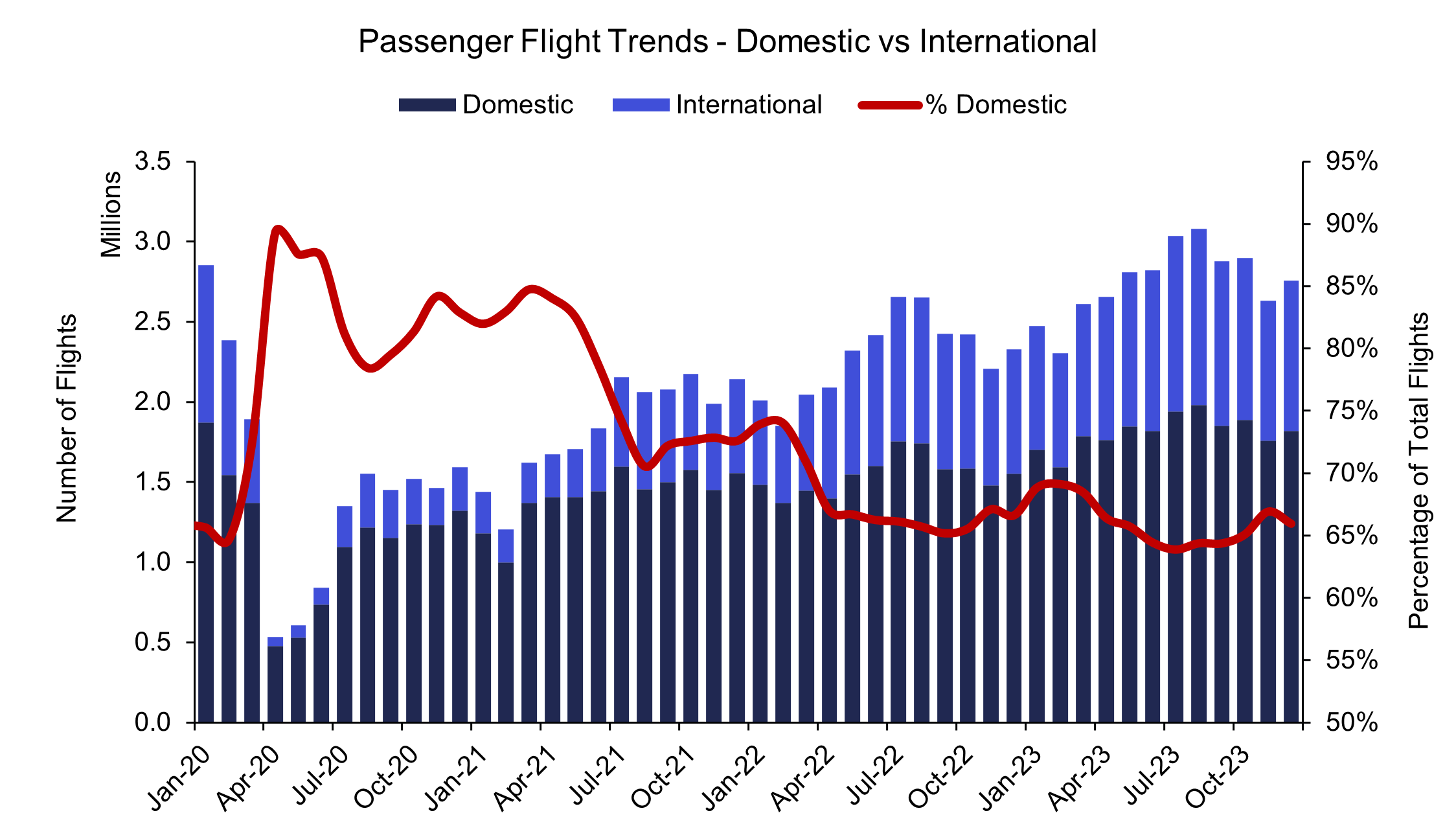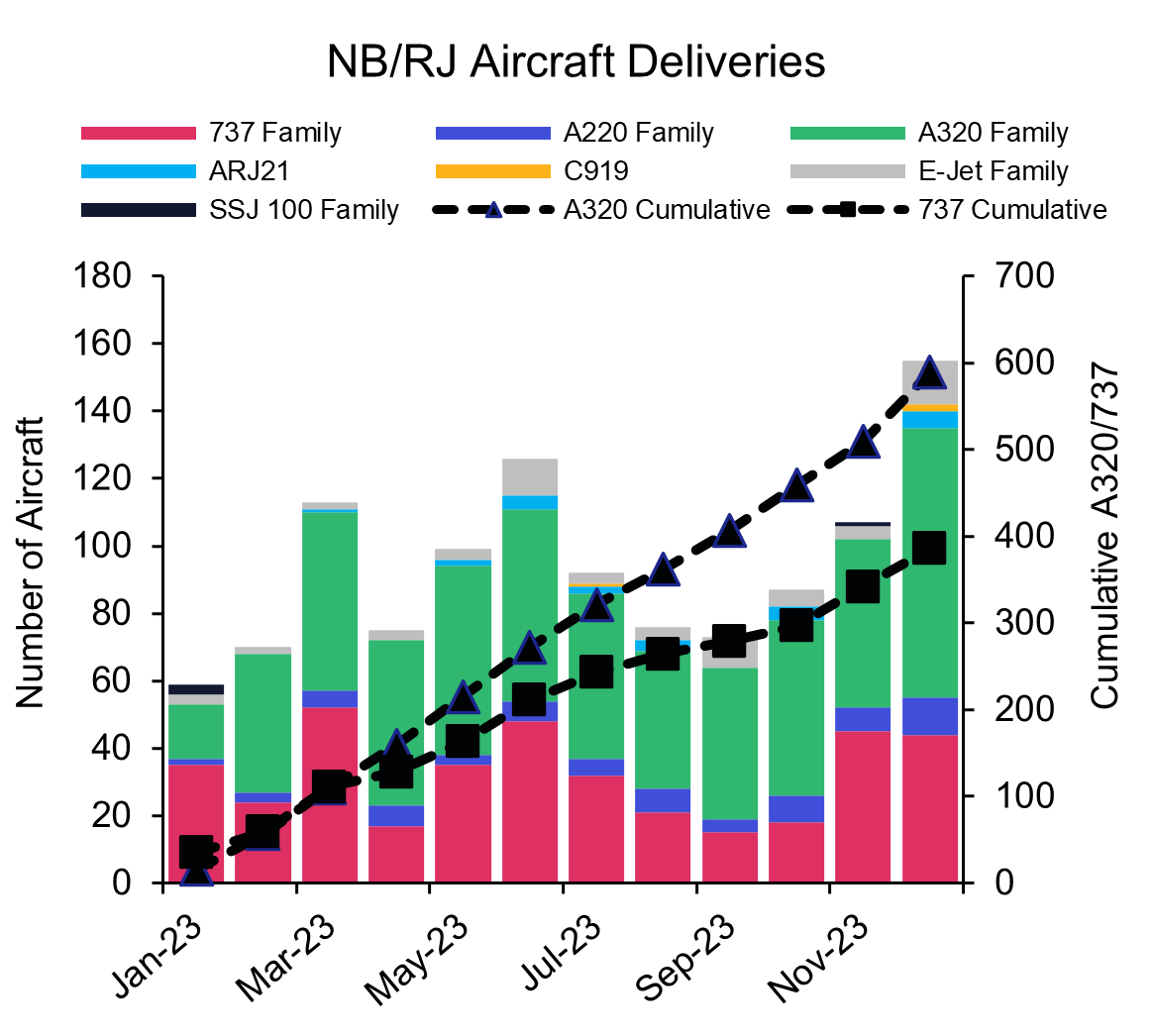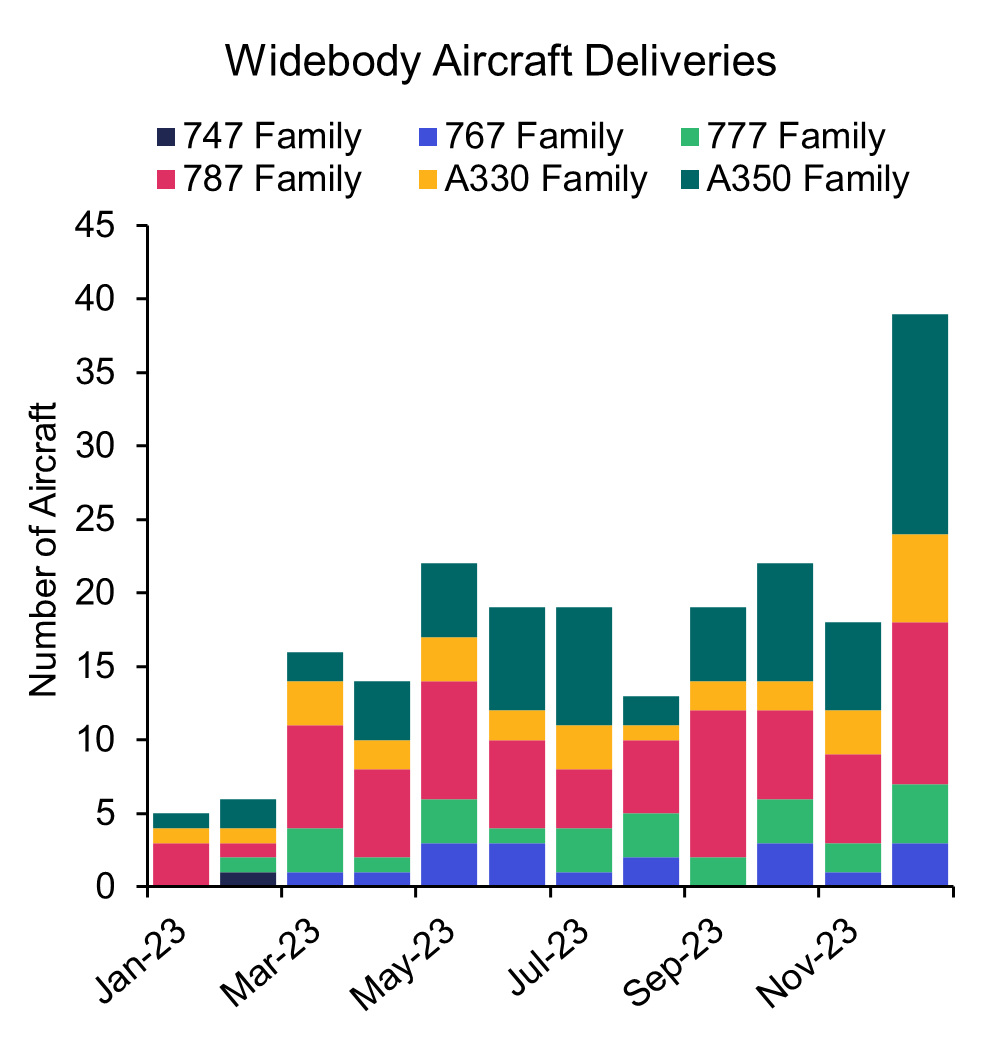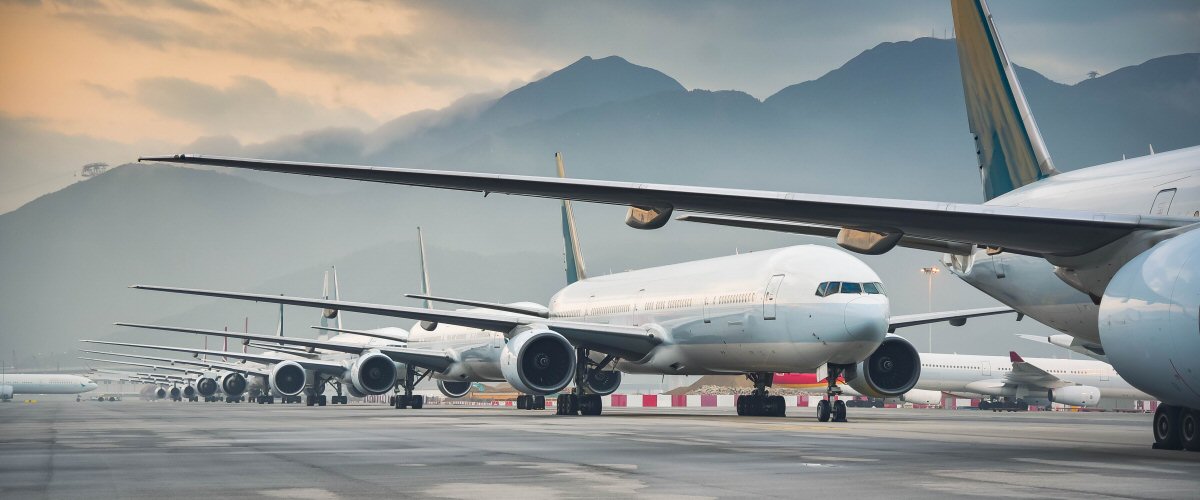Date: 02/02/2024 (Edition 2) Download PDF
.png)
Goodbye Dry January…
Thankfully, another successful Dublin conference has drawn to a close, and as expected, the mood was positive. Well, positive about the tight demand for practically everything, but not a lot of positivity around OEM supply though. Largely the same sentiment was echoed from the stage, throughout meetings, and in the pubs.
However, the flavour was more varied than that. To list but a few…
Overall, asset-wise, everyone with skin in the game was upbeat about the tight market. Pricing and Lease Rates are up, and defaults are down. This is good for lessor, lender or investor returns for assets in place. However, for those either looking to grow or reliant on moving dynamics, it is more frustrating, and they were the ones who remained quietly cautious.
An interesting story throughout 2023 has been the difference in performance between the US low-cost sector and legacy carriers. From late 2022, the latter managed to get long-haul back online which plumped up their margins, cushioning against the sustained high fuel price and salary hikes. The low-cost sector had no such luck.
Whilst Spirit Airlines’ results are fully expected to be poor ($9m EBIT margin of -6.9%), it was slightly disheartening to also see JetBlue report negative margins for FY 2023 (-2.4% EBIT margin and -3.3% net margin). This is perhaps showing that the, now blocked, merger was out of necessity, rather than JetBlue having great growth ambitions. Southwest Airlines did manage to remain in the black (net margin of 1.9%). Interestingly, with a low use of leasing and debt, Southwest’s net finance income of $409m exceeded the operating income of $267m. Foreshadowing Spirit’s results, when they do come in, it is not a good sign when management is referencing potential GTF engine-related compensation payments as a source of liquidity, as they did earlier this month...
The brighter side of the story is how the full-service carriers continue to improve. The hierarchy was the same as in 2022, with Delta Air Lines leading the way in both EBIT margin (9.5%) and net margin (7.9%). United Airlines (EBIT margin 7.8% and net margin 4.9%) and American Airlines (EBIT margin 3.3% and net margin 1.6%) both improved on both fronts compared to 2022, as well. In the case of Delta, the net profit upswing was by over 53bps. This is significant to note as during the pandemic recovery, North American carriers defied other regions and cumulatively upped their net debt in 2022. This was partly due to some airlines’ struggles but also an appetite for CapEx more than debt repayment. At first inspection this would appear to be changing, however, this upswing was primarily driven by a $1.2bn gain on investments (compared to a $783m loss in 2022). They took out $416m more financing in 2023 and the gamble appears to be paying off!
All three carriers benefitted from a fuel cost decrease of circa 5-10% whilst their ASKs increased. However, American’s increase in ASK (+6.7%) lagged both United’s (+17.5%) and Delta’s (+19%). Over the year, Delta also increased yield by 2% with management saying that their ‘premium and non-ticket’ segment had reached 55% of revenue. All have also achieved the laudable trio of simultaneous yield, capacity and load factor increase. Again, Delta led, up (+1.6%) to 85.4%, while American improved (by +0.6%) to 83.5% and United improved (by +0.5%) to 83.9%.
It should be noted that the road ahead may not be as easy. Despite the cumulative positive movement, all three experienced a yield drop in Q4, which may continue into the new year. They also have Boeing’s production worries to contend with. Due to the latter, United revised its growth ambitions down and publicly criticised the OEM in the media. Finally, Delta has been warned of their joint venture with Aeroméxico being in the sights of the U.S. Department of Transportation. It seems that consolidation does not translate into American English.
From talking about the crusade of anti-trust officials to a company whose parent has just survived one, or perhaps not. The Brazilian full-service carrier, GOL Airlines, announced last week that it was entering Chapter 11 bankruptcy proceedings. The carrier has not turned a profit since the onset of the pandemic, but its debt load reportedly reached $4.2bn at year-end. Crucially, as of Q3-23, it had $2.8bn having a maturity within a year.
GOL is an interesting case study of looking beyond income statements, as their operating performance for the first nine months of 2023 had turned a very healthy operating profit (EBIT margin 15.7%), and the net loss was shallow (net margin -0.9%). The gap between the two was telling, however, and it was clear from looking at the cash flow statement and balance sheet that debt was getting out of control. The increase in debt increased the principal that interest was acting on, but also the rate they would need to pay on the new debt. For context, GOL’s bonds had been trading at around 30 cents on the dollar before the announcement. Now it sits at 16.
However, the picture is not entirely gloomy for GOL. Firstly, the operational performance should not be overlooked. The airline has managed to pull itself into profitability, whilst titans in the region LATAM, Avianca and Aeroméxico all required restructures through the pandemic. The airline also has more than one lifeline. To start with, its parent company, Abra Group, contains Avianca, who will be able to prop them up to an extent. As mentioned earlier, they were unfortunate to not get the Viva Air Colombia acquisition over the line, however, they will have benefitted from the latter’s demise reducing competition. The Abra Group has reportedly planned $950m in new financing, with $350m already approved.
On top of the private financing, the Brazilian government is discussing establishing a $605m fund for local airlines, issued by the Brazilian Development Bank (BNDES). The hope is that the two sources of financing (as well as restructuring the debt) can reign in interest payments and pull the airline back into net profit, whereby they can generate cash to pay off debt in earnest. In terms of profitability, they are not far off!
The funding is not an extortionate amount when one compares it to the $2bn that the Argentine government gave to Aerolíneas Argentinas over 3 years during the pandemic. For all intents and purposes, this made them a Public Service Obligation (PSO) carrier. IBA’s Latin America forecast often invites questions as to its positive view (11.0% EBIT margin in 2024). However, this needs to be contextualised that Aerolíneas Argentinas’ outlier $1.2bn EBIT loss in 2019 almost single-handedly wiped out the rest of the region’s profit. Therefore, that year doesn’t act as a good benchmark. The Argentine carrier is now predicting its first profit in 15 years. If GOL can be saved, the region may be on for the bumper year that their nine-month margins were suggesting!
Our regular update looks at the key trends and market indicators using data and analytics provided by IBA Insight.




Introducing IBA Insight, IBA NetZero and IBA Airlines – aviation's one-stop shop for intelligence. You need quick, intuitive access to the most accurate commercial aviation data. Our products are designed to provide you with seamless and simple analysis, prompting better asset decisions, enhanced risk management, and a full understanding of aviation decarbonisation strategies.

With our large team of award-winning ISTAT-qualified appraisers and over 35+ years' proprietary data, IBA is a leading player in the valuations market. Working globally, we offer independent, impartial opinion and advice on the value of a range of asset types including aircraft, engines, helicopters, freighters and air cargo, landing slots and spares. Always striving to exceed clients' expectations, IBA's objective judgement supports the required security needed for loans, asset repossession, commercial development and remarketing.

IBA works with leading aircraft and engine leasing companies from around the world. Our depth of industry knowledge informs our expert advice so we can support clients through the investment cycle, inspiring confidence at every stage of their journey. From valuations, fleet selection and portfolio development to redelivery and remarketing at lease end, we accompany clients through every risk assessment and asset management activity during the life of the lease.

Aviation investment can be an intricate affair and, with significant financial stakes involved, leaving things to chance is not an option. Whether you are investing for the first time or an established player in the market, IBA can help you cut through the complexities of the asset class to better understand investment opportunities. We can work with you to support portfolio development, diversification and to meet strategic needs.

For over 30 years IBA has worked with global and regional airlines providing valuation and advisory services, aviation data intelligence and aircraft and engine redelivery support. Working collaboratively on a variety of aviation projects spanning the world, we fulfil clients' additional resource requirements and provide project management support wherever and whenever needed.

We take a resourceful approach to litigation support and dispute resolution, identifying thoughtful solutions that are tailored to our clients' legal strategy. Our access to over 30 years of proprietary aviation data, regular involvement in strategic M&A and aircraft management expertise affords us regular access to the typical areas of contention between parties. IBA assists clients directly or via their legal teams across many aspects ranging from insurance related settlement for aircraft damage or loss, to disputes between lessors and lessees - often at redelivery.